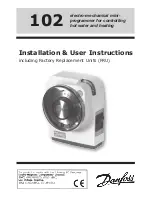
User Manual
BC4000 Series RAID Controllers
02/13/06
B ro ad c om C o r p or at i on
Document
BC4000-UM100-R
Expanding Disk Capacity Online
Page 3
•
RAID5
: RAID5, also known as a stripe with parity, stripes data as well as parity across all drives in the
array. Parity information is interspersed across the drive array. In the event of a failure, the controller can
restore the lost data of the failed drive from the other surviving drives. This array type offers exceptional
read performance as well as redundancy. In general, write performance is not an issue due to the
tendency of operating systems to perform many more reads than writes. This array type requires only one
extra disk to offer redundancy. For most systems with four or more disks, this is the correct choice as array
type.
•
RAID50
: RAID50, also known as striped RAID5 sets, intersperses parity information across each RAID5
set in the array. This array type offers good read performance as well as redundancy. A 6-drive array
provides two striped 3-drive RAID5 sets. Generally, RAID50 is useful in very large arrays, arrays with 10 or
more disks. Like the RAID1n and RAID10n array types, RAID50 can handle multiple disk failures.
For the minimum disk requirements for each type of array, see
“Expanding Disk Capacity Online” on page 3
.
See also
“Performance Considerations” on page 4
to learn how to maximize the performance of your arrays.
E
XPANDING
D
ISK
C
APACITY
O
NLINE
Online capacity expansion (OCE) allows you to add any number of disks to an array at any time and continue
to access the array data while it is being redistributed.
To increase the size and organization of an array, transform the array. You can also use the transform function
as an integral part of the system backup and recover strategy through the use of the RAID1, RAID10, RAID1n,
and RAID10n array types. For more information on transforming arrays from RAIDConsole, see
“Transforming
Arrays” on page 84
. For more information on transforming arrays from bcadm, see
“Transforming Arrays:
bcadm --transform” on page 134
.
M
IGRATING
RAID L
EVELS
O
NLINE
With Online RAID Level Migration (ORLM), you can easily move from one RAID level to another. While the
migration is taking place, the data is accessible and protected to the lowest protection of either the source RAID
level or the destination RAID level.
The transform feature can be used to increase the size and organization of an array. It can also be used as an
integral part of the system backup and recover strategy through the use of the RAID1, RAID10, RAID1n, and
RAID10n array types. To do this from RAIDConsole, see
“Transforming Arrays” on page 84
, and from bcadm,
see
“Transforming Arrays: bcadm --transform” on page 134
.
















































